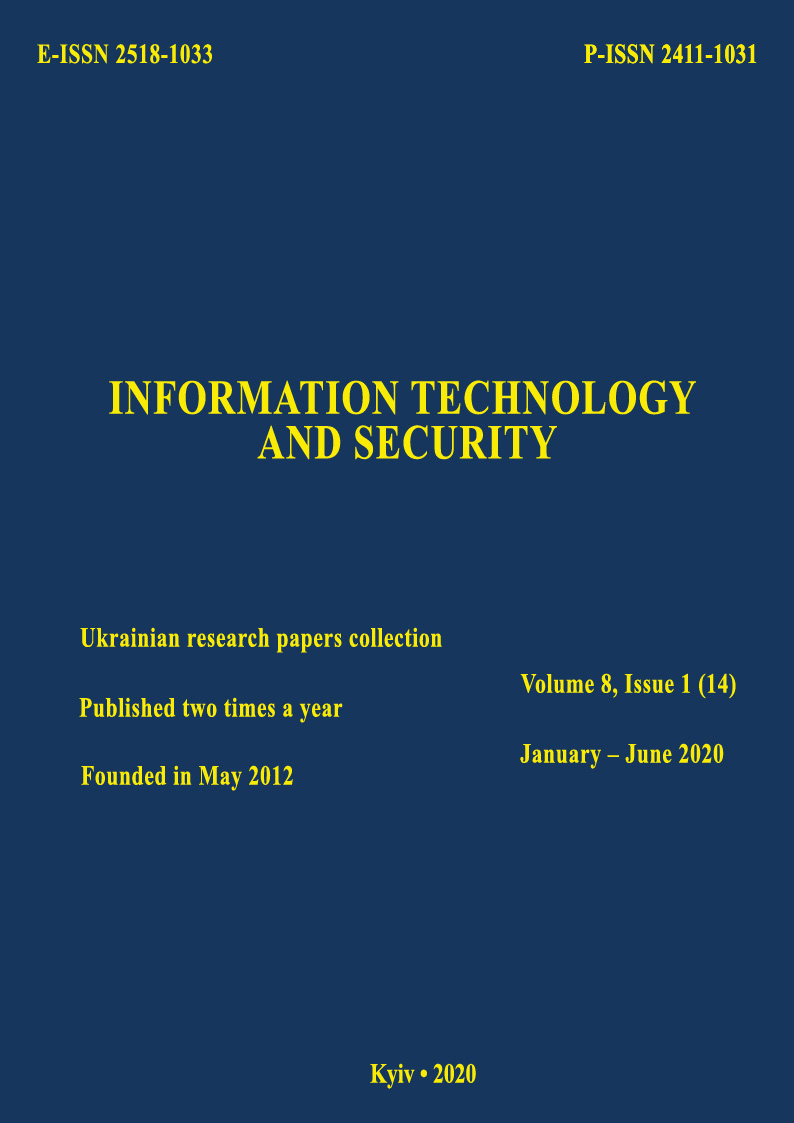Discrete Markov model of information and communication processes for crowd formation
DOI:
https://doi.org/10.20535/2411-1031.2020.8.1.218008Keywords:
crowd, modeling, software, information and communication processes, information and psychological influence, random variable, characteristics of the random variable, mathematical modelAbstract
The discrete Markov model of information and communication processes that take place in the crowd during its formation is considered. The context of the model description is based on the use of probabilistic characteristics and Markov chains. The use of Markov chains in the context of the study of crowd formation is due to the need to determine the possibility of the crowd functioning in a given state, including the possibility of the process of mutual agreement of probabilistic random variables. Thus, the purpose of this model is to analyze the information and communication processes in the formation of the crowd, because the course of processes into the crowd directly depends on the state in which the crowd is represented and the values of random variables. This allows you to identify and predict the possible course of events in the crowd during its formation. In this case, the whole process of crowd formation can be divided into a certain set of states in which the crowd passes under the influence of external factors. Using the formed states, random sizes of the process of formation of the crowd are defined. This makes it possible to construct a random variable distribution function based on the laws of probability theory, which makes it possible to determine with a given accuracy what is the probability of realization of a certain random variation of the studied transient process. To determine the possibility of functioning of the transient process, the average value of a random variable that realizes the mathematical expectation is calculated. To determine the scattering index of the value of the mathematical expectation, the value of the variance is calculated. Since the process in the course of its implementation can be performed partially, fully, or not performed at all, the standard deviation is calculated, which shows how much on average the specific values of the random variable deviate from their mean value. Thus, the discrete Markov model of information and communication processes for crowd formation allows developing an algorithm that can determine the type of crowd, the possibility of a certain transition process, and the representation of crowd objects in space in the form of clusters. The peculiarity of this model is that the results of the obtained values are processed with a given accuracy.
References
V. M. Petrik, M. M. Prysyazhnyuk, and Ya. M. Zharkov. Information and psychological confrontation. Kyiv, Ukraine: Igor Sikorsky KPI Publishing House, 2018.
O. Tsehelnyk, and T. Khrapko, “Crowd as a social danger”, Innovatsiini tekhnolohii u vyrobnytstvi ta pidhotovtsi fakhivtsiv tekhnolohichnoi, profesiinoi osvity ta sfery obsluhovuvannia. Kherson, Ukraine : Ailant, 2015, pp. 91-94.
V. N. Turchin, and E. V. Turchin. Markov chains, basic concepts, examples, problems. Dnipro, Ukraine: LizunovPress, 2017.
Abstracts of the Eleventh International Scientific and Practical Conference. Mathematical and simulation modeling of MODS systems, Ministry of Education and Science of Ukraine, National Academy of Sciences of Ukraine, Academy of Technological Sciences of Ukraine, Engineering Academy of Ukraine. Chernihiv: ChNTU, 2016.
О. В. Wave. Mathematical modeling. Ivano-Frankivsk, Ukraine: Vasyl Stefanyk Precarpathian National University, 2015.
І. О. Hvischun. Programming and mathematical modeling. Kyiv, Ukraine: In Yure Publishing House, 2007.
Basel M. Al-Eideh, “Quasi Stationary Distributions in Markov Chains with Absorbing Subchains”, Journal of Information and Optimization Sciences, vol. 16, no. 2, pp. 281-286, 1994, doi: https://doi.org/10.1080/02522667.1995.10699224.
F. H. Vashchuk, O. H. Laver, and N. Ya. Shumylo. There was a noise. Mathematical programming and elements of variational calculus, Kyiv, Ukraine: Znannia Publishing House, 2008.
M. Heiliö, et al. Mathematical Modelling, New York, USA: Springer, 2016, doi: https://doi.org/10.1007/978-3-319-27836-0.
G. A. Stillman, W. Blum, and G. Kaiser. Mathematical Modeling and Applications, International Perspectives on the Teaching and Learning of Mathematical Modeling. New York, USA: Springer, 2017, doi: https://doi.org/10.1007/978-3-319-62968-1.
S. S. Zabara, B. M. Nedashkivsky, and S. M. Nedashkivsky, “Neural networks and image analysis”, Bulletin of the University “Ukraine”, no. 2, pp. 125-133, 2016.
L. Fumagalli, A. Polenghi, E. Negri, and I. Roda, ”Framework for simulation software selection”, Journal of Simulation, vol. 13, iss. 4, pp. 286-303, 2019, doi: https://doi.org/10.108017477778.2019.1598782.
Downloads
Published
How to Cite
Issue
Section
License
Copyright (c) 2020 Information technology and security

This work is licensed under a Creative Commons Attribution 4.0 International License.
The authors that are published in this collection, agree to the following terms:
- The authors reserve the right to authorship of their work and pass the collection right of first publication this work is licensed under the Creative Commons Attribution License, which allows others to freely distribute the published work with the obligatory reference to the authors of the original work and the first publication of the work in this collection.
- The authors have the right to conclude an agreement on exclusive distribution of the work in the form in which it was published this anthology (for example, to place the work in a digital repository institution or to publish in the structure of the monograph), provided that references to the first publication of the work in this collection.
- Policy of the journal allows and encourages the placement of authors on the Internet (for example, in storage facilities or on personal web sites) the manuscript of the work, prior to the submission of the manuscript to the editor, and during its editorial processing, as it contributes to productive scientific discussion and positive effect on the efficiency and dynamics of citations of published work (see The Effect of Open Access).

